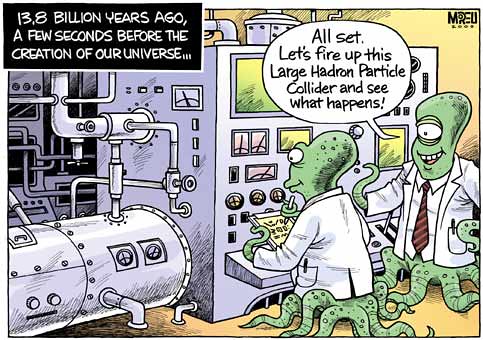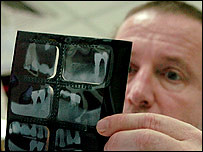More Cool, Mind-Blowing Facts!
Jun 6 at 3:03pm by Aileen
Here are some more strange (and very disturbing) facts about the human body, from Vicki over at the One Big Health Nut blog…

• Nearly 50% of the bacteria in your body (and humans harbor 3 times more bacterial cells than human cells) live on the surface of your tongue, which (by the way) is the strongest muscle in your body. Probably a good reason why Mommy-Kisses work better than Mommy-Licks on boo-boos.
• The incidence of immune system diseases has increased more than 200% in the last five years. Yikes! Is that environmental?
• By the time a person is 35 years old, s/he begins losing about 7,000 brain cells a day which are never replaced. Whoa. I’d say something profound about that, but I forgot what the subject was…
• A moderate sunburn damages blood vessels in the skin so seriously that it takes between four and fifteen months for them to heal. The reason I keep SPF 50 on hand all summer.
• Right-handed people live an average of nine years longer than left-handed people. Need I remind readers that correlation does NOT equal causation?
Go on over to One Big Health Nut and read the rest for yourself!
Research: You CAN Teach an Old Dog New Tricks
Sep 28 at 6:06pm by Aileen

It started way back in 2002, when researchers at the Linus Pauling Institute at Oregon State University discovered some Compounds That Rejuvenate Rats, May Aid Humans. Actually, it was a combination of dietary supplements that dramatically improved the activity, energy level and cognitive function of old lab rats. The micro-nutrient compounds were identified as acetyl-L-carnitine and alpha lipoic acid.
Lipoic acid comes naturally in organ meats as well as spinach, broccoli and potatoes. Acetylcarnitine is found in red meats, milk, fish and chicken. Best vegetable sources are avacado, whole wheat and asparagus.
Accidental Intelligent Design
Sep 15 at 5:05pm by Aileen

Is It Magic or Is It Art?
Mar 4 at 7:07pm by Aileen

This is a photograph of 1,301 florescent light tubes arrayed in a field beneath standard high power electrical lines. The energy causing them to glow is the magnetic field produced by those high power electrical lines.
No, it’s not there to demonstrate that the fields do in fact have real effects (despite what the government and electrical power lobby tells you). It’s a very interesting art project by artist Richard Box.
Technical Innovation and Pandemics
May 3 at 1:01pm by Ryan
Sometimes simple things remind you how privileged we are at this time in history.
Consider this: you can receive text-messages on your cell phone that update you about the current state of the Swin Flu pandemic. There has never been a time in history when you could get such useful information so quickly.
Or think about the extraordinary level of global cooperation regarding protocols for keeping Swine Flu in check. While some people might be complaining about over-reaction, I for one and am extremely grateful for the extraordinary care that’s being taken to prevent mass death.
Score one for innovation and technological progress.
Update on Wind and Grid Issues
Dec 17 at 7:07pm by Aileen

As the economy slips ever farther down the black hole of imaginary values and criminal greed, the looming necessity for using this crossroads of history to re-make our energy future has moved the issues up on the To-Do list. America’s automakers are lining up, hats in hand, to obtain enough funding to keep their (union) workers employed, and the funds they want may come attached to serious strings that require more gas-efficient cars, hybrids, flex-fuel and even new lines of plug-in electric cars to help get us off our addiction to other nations’ oil.
Which then begs questions about what sources of electrical energy we need to develop that do not spew greenhouse gases into the air, leave us with millions of tons of toxic or radioactive industrial waste, and cause serious detrimental health effects (and death) to the population. Following on the issue of our choices for future development is the antiquated state of our electrical grid, which is both inefficient and dangerously likely to fail altogether without much trouble.
Fact is, energy use conservation could make a more serious dent in our consumption without doing anything at all. This is what happened this past summer when gasoline prices climbed to around $5 per gallon, and diesel prices became inverted. Millions of people limited their driving, pooled for shopping excursions, and stayed home instead of driving long distances for vacation. Petroleum usage plummeted, which informs us that we don’t really have to use as much as we do. Changing light bulbs and turning off lights and appliances and turning down the thermostat can save quite a bit of our generation capacity too, but that will of course jump when we have to charge our cars at night.
I Gotta Get Me One of Those!
Aug 12 at 3:03pm by Aileen
Invisibility Cloak One Step Closer: New Metamaterials Bend Light Backwards

In J.K. Rowling’s Harry Potter series, the boy wizard inherited an invisibility cloak from his father. He could use it to sneak around undetected through the stony halls of Hogwart’s School of Witchcraft and Wizardry, to escape the confines of the same place, and to spy on the plots and plans and deeds of other characters in the story. If you’re 8 years old, the thought of your own personal invisibility cloak is highly entertaining.
Enter scientists – presumably older than 8 – at the University of California at Berkeley, who announced this week that they have engineered some nifty “metamaterials” that can bend light rays around an object to render them effectively invisible. The entertaining dream just became reality, but will likely be reserved mostly for spies and other, more lethal tools of military stealth. Alas, we probably won’t be able to buy our own invisibility cloaks at WalMart any time soon.
Research published in Science describes a metamaterial composed of silver nanowires grown inside a porous aluminum oxide. The result is a structure about 10 times thinner than a sheet of paper that can refract light ‘backwards’ to render a cloaked object invisible to human eyes, radar, and near-infrared wavelengths as short as 660 nanometers. Nature looks at a ‘fishnet’ metamaterial and its possibilities.
We should probably not let the Romulans know about this development. Let them invent their own cloaking device!
MIT Scientist Offers ‘Solar Revolution’
Aug 1 at 5:05pm by Aileen
‘Safe, Clean, Too Cheap to Meter’ finally means something!

photo: Donna Coveney
MIT and Science [July 31] announce that Scientists mimic essence of plant’s energy storage system in a breakthrough that promises to make rooftop solar power a reliable mainstream energy source, even for when the sun isn’t shining.
Nocera and postdoctoral fellow Matthew Kanan have developed a process of artificial photosynthesis that will use solar energy to split water into hydrogen and oxygen, and using the gases to power a fuel cell that will provide electricity at night and on cloudy days. A leader in the study of photosynthesis James Barber said of the work, “The importance of their discovery cannot be overstated since it opens up the door for developing new technologies for energy production, thus reducing our dependence on fossil fuels and addressing the global climate change problem.”
The inexpensive catalyst Nocera and Kanan developed can split the molecules in a glass of water at room temperature, a process that until now has been expensive because suitable catalysts were too expensive or made of rare materials. The discovery is an outgrowth of research into artificial photosynthesis (the process plants use to split water for energy) by many chemical research groups.
“This discovery is simply groundbreaking,” said Karsten Meyer, professor of chemistry at a German university. In the development of solar energy, Meyer said, “this is probably the most important single discovery of the century.”
Nocera predicts the technology can be developed quickly and readily available within ten years to address the world’s energy needs. Technical details of the discovery and process are sketched out in the MIT release, and examined in more depth in Technology Review in their article Solar-Power Breakthrough.
Cancer Researcher Warns Cell Phone Users
Jul 24 at 9:09pm by Aileen

In an unprecedented move, the head of a prominent cancer research institute issued a warning to his faculty and staff on July 23, that cell phone use may pose a cancer risk to users.
There is no consensus in science that electromagnetic radiation in radio frequencies – such as is emitted by cellular phones and is absorbed by the user’s head – causes or increases the risks of brain tumors. Yet Dr. Ronald B. Herberman, director of the University of Pittsburgh Cancer Institute, said he issued the warning because the question is still being researched, and it is better to err on the safe side than to be sorry later on.
Of particular concern to Herberman is the increasing use of cell phones by children, whose brains are still developing. The body of research on the question is ongoing, but so far has demonstrated no firm link between cell phones and cancer. The fact that it takes a relatively long time for cancers from environmental sources to show up in a population leaves risks of cancer from long term exposure to the radiation an unanswered question.
One bit of interesting research on cell phone radiation recently came from Clermont-Ferrand University in France, where it was found that…
…tomatoes, when exposed to the magnetic waves of mobile phones, get stressed within ten minutes. They start secreting a molecule which usually only occurs when they get damaged.
If tomatoes can physiologically go into stress mode when cell phones are present in their vicinity, it’s certainly possible that physiological effects may occur in animals – including humans. I’d like to see some mouse studies. But in the meantime, remote use of the device (so it’s not sitting on your ear) isn’t that bad an idea.
A pretty strong warning can also be made that if you grow tomatoes, don’t take your cell phone when tending them. The world won’t stop turning if you’re out of communications availability for a little while. Honest.
Are Carbon Nanotubes Dangerous Like Asbestos?
May 27 at 4:04pm by Aileen

ScienceNews reported last week that research on mice suggests these new fullerene-based wonder-fibers may be as dangerous as asbestos in the environment. The study showed that multi-walled (rigid) nanotube fibers longer than 15 micrometers cannot be removed from sensitive organic tissues by microphages, and that this causes inflammation that could lead to asbestos-like diseases including mesothelioma, a fatal form of cancer.
The study was published in the May 20 online edition of Nature Nanotechnology, and according to the Washington Post serves as a preliminary warning that there may be serious issues with the technology that warrant very careful planning to protect industrial workers, the public and the environment as nanotube fibers become more common in consumer and industrial products.
Companies around the world produce thousands of tons of nanomaterials a year, not all of them in the form that poses the threat identified by these researchers. Nanotubes alone are expected to become a multi-billion dollar industry within the next few years. While the government pumps about $1.5 billion a year into R&D for nanotechnology, only about 5 percent of that goes into health and safety concerns.
It would be quite refreshing if, for a change, we incorporated the lessons of history as we develop this promising new technology to forestall issues related to health, safety and environmental pollution before they become just more grim statistics attached to greed over due caution. And for this reason the situation bears watching to see if identified areas of concern are simply denied and swept under a profit rug, or rationally dealt with as if humans could accept responsibility – and minimize risks – per the less than hopeful side-effects of our intelligent designs.
Painted-On Solar Cells
Mar 14 at 7:07pm by Aileen

Great news this week on ScienceDaily, picked up by Nanotechnology News and other outlets that researchers from Swansea University has developed a paint coating for steel buildings that will generate electricity even in low light situations.
Check it out at Wise Living Journal.
Automated ID System for Mass Disaster Victims
Feb 27 at 12:12am by Aileen

Japanese researchers have developed a New Automated System to identify victims of mass disasters. The type of disasters that usually end up with nothing but dental records for identification (if not DNA)… airplane crashes, suicide bombings, building collapses and such, where the victims come in small pieces, usually charred to a crisp.
The new system is a novel dental x-ray matching system that reduces the real-time input of forensic experts puzzling over parts of jaws and improves the accuracy of the results at the same time. Which is of course ‘good’ for the relatives of those victims waiting for something to bury with full honors in the family plot.
Mass disasters happen in this modern world, both natural and unnatural. Nearly 3,000 people died when terrorists flew planes into the Twin Towers in 2001, and the grizzly scenes of bombings in the Middle East are standard daily fare on the news. There are also earthquakes, tsunamis, floods and cyclones that kill hundreds or thousands at a time, not all of them found inside a home where it’s pretty easy to guess who they were.
This new Japanese system can make a positive match in less than 4 seconds. Let’s face it – that’s a lot faster than any of us as next-of-kin could identify a piece of jaw as belonging to someone we’ve known all their lives. And that can be a good thing for those left behind.
Link:
New Automated System IDs Victims of Mass Disasters in Minutes
Invitations Sent, Date to Be Announced…
Feb 21 at 11:11pm by Aileen
Will the Candidates Show?


Government leaders, university presidents, leading scientists, engineering leaders, business executives, American innovators have been making the call loudly and with some help from NPR, MSNBC, the New York Times and Time Magazine as well as increasing numbers of other media outlets. Now that both the Democratic and Republican fields of potential Presidential candidates are down to two apiece, it’s time for Science Debate 2008 to happen.
The invitations to the candidates have been sent, the debate will be held at the Franklin Institute in Philadelphia before the Pennsylvania primary on April 22. Thus far none of the candidates have responded that they will commit. While we all know that issues of science and technology are usually handled by advisors who have knowledge of the subjects, it would be nice to get a feel for whether the candidates for our country’s highest office have a basic grasp of those issues and a defensible position on policy. Or find out if all they’re good for is to mouth sound bites their handlers feed them.
If you’re interested in what you may be able to do to help convince them, visit the Science Debate 2008 website and sign on. And it wouldn’t hurt to write to the campaigns and request the candidates’ participation while you’re at it.
Global Warming, Biodiversity and Biofuels
Oct 12 at 5:05pm by Aileen

The dramatic breakup of the northern ice sheet has tended to confirm global warming, and there are other indications that things are worse than we thought. Turns out that North America’s Northernmost Lake is showing signs of climate change too.
An international research team reports that a core sample of lake bed sediment indicates a drastic change in algae and diatom concentrations in the lake over the last 200 years, but not in the 8,000 years prior – when the lake was permanently frozen. This tends to support the hypothesis that human industrialization has contributed to the warming.
Even if we stopped releasing greenhouse gases today we’d still have to deal with the effects of climate change, and this has been a concern for important ecosystems’ stability. Good news is that researchers have discovered Forests of Endangered Tropical Kelp surviving just fine in the deep waters off the Galapagos Islands.
No comments:
Post a Comment